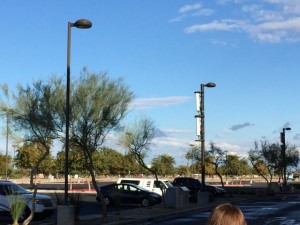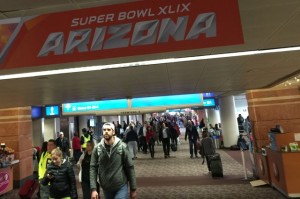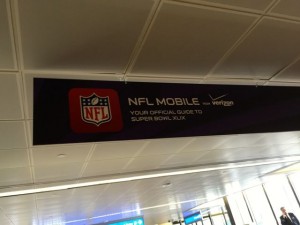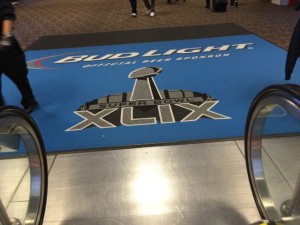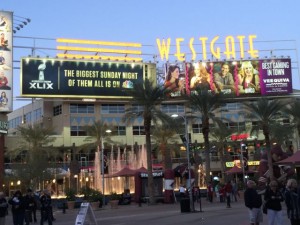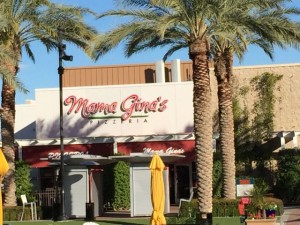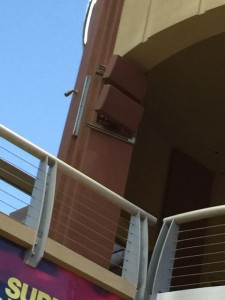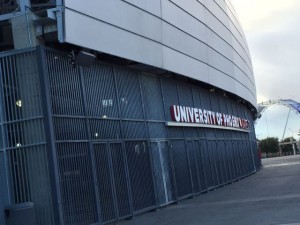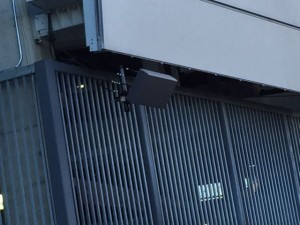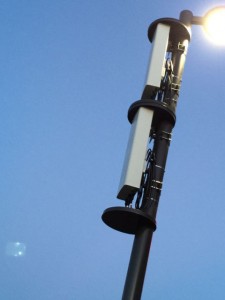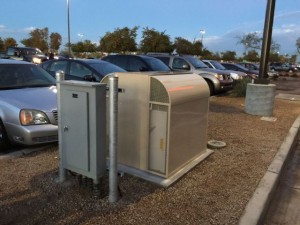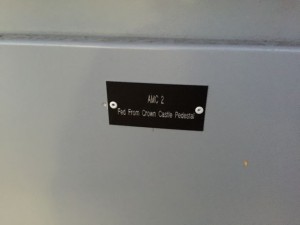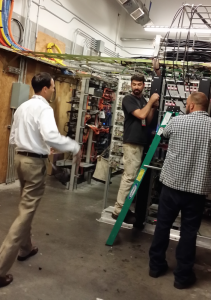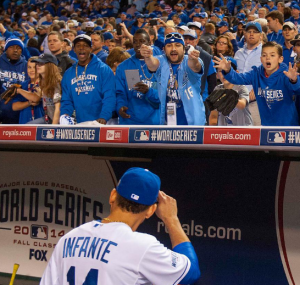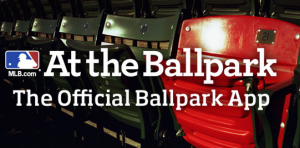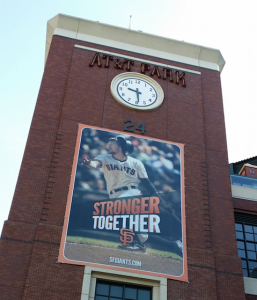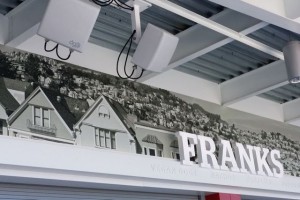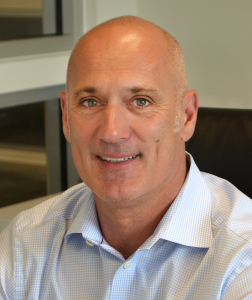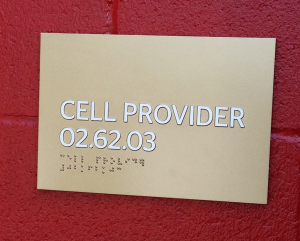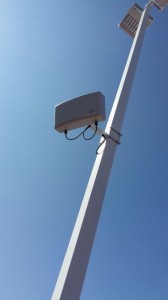Editor’s note: This story is part 1 of a series of profiles of the providers of the extensive Distributed Antenna System (DAS) deployment for Super Bowl XLIX at and around the University of Phoenix Stadium in Glendale, Ariz. and other parts of the Phoenix city area as well. Stay tuned all week as we highlight how DAS will keep Super Bowl fans connected, no matter where they roam in and around Phoenix and Glendale this week and weekend.
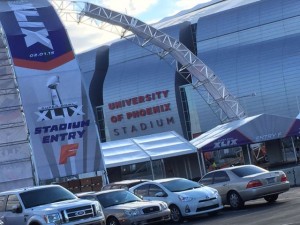
University of Phoenix Stadium getting its Super Bowl on. (Click any photo for a larger image) Credit all photos: Paul Kapustka, MSR
But to stadium technology connectivity professionals, such leaps of aesthetic deception are just part of a day’s, or perhaps month’s, DAS deployment work. For neutral host DAS provider Crown Castle, the fake vents on the shell of the University of Phoenix Stadium — and the powerful antennas behind — are just one part of a massive project to ensure there is excellent mobile-device connectivity both inside and outside the Super Bowl stadium, so that fans never get a dropped signal anywhere between the parking lot and their prized seat.
During a recent press tour, a small team of Crown Castle employees showed off some of the upgraded DAS network deployed at the University of Phoenix Stadium as well as in the surrounding Westgate Sports and Entertainment District, a sort of open-air mall that stretches from the UoP Stadium past numerous attached restaurants and stores, also encompassing the Gila River Arena, home of the Phoenix Coyotes of the NHL. Over the past year or so, Crown Castle has been upgrading the DAS inside and outside the arena, throughout the mall areas as well as into the huge parking lots that surround it and the football stadium, bringing connectivity to phones being used by customers from all the four major U.S. wireless carriers.
Since the mall and all its food outlets are conveniently located a short stroll from the stadium, it’s a good bet that a large portion of the Super Bowl crowd will spend time wandering around the Westgate area before and after the big game. Thanks to Crown Castle’s efforts, there shouldn’t be many connectivity problems, as antenna deployments on light poles, building rooftops and — yes, even behind fake vents — should be able to keep devices on the cellular networks without a glitch.
Game day connectivity starts in the parking lot
Since we couldn’t actually spend much time wandering around the stadium itself — even three weeks before the big game, the facility was already on NFL security lockdown — most of the Crown Castle tour consisted of walking around the Westgate mall/neighborhood, hearing about the various methods Crown Castle used to locate the necessary DAS antennas. In all, there are five separate DAS networks Crown Castle is responsible for in the area around the stadium: The football stadium itself; the Gila River Arena (which we will profile in an upcoming feature on hockey stadiums); the Westgate shops and restaurants; the nearby Renaissance Hotel; and the surrounding parking lots.
The curious start of the tour in a far-flung parking lot made sense when we found ourselves next to a small DAS equipment box and a light pole with multiple antennas (which had not yet been covered with their final aesthetic sheaths). Aaron Lamoureux, program manager for Crown Castle’s small cell solutions, served as tour guide, and said that for the Westgate area alone there were 18 individual node locations, with about 52 antennas total. Some were located on light poles, some on rooftops, and some along walkways between buildings, to conquer the unique RF characteristics of the open-air/large building outdoor mallish area that is Westgate. (See photos for DAS geek views)For the University of Phoenix Stadium itself, Crown Castle deployed 228 DAS antennas inside (more on this in an upcoming profile) and at 21 different locations outside the stadium, 13 of those on parking lot poles and 8 mounted on the building itself. Why building-mounted antennas? If you’ve never been there, the University of Phoenix Stadium has a large plaza area on one side, which is used for pre-game activities like rallies, bands and other walk-up amenities where fans gather before entering. The challenge for Crown Castle was finding places to deploy antennas at a low enough height to cover crowds of people standing in one location. While some parts of the building allowed for regular antenna placements, a big part of the plaza faces part of the stadium wall that is a sheer sheet, with no aesthetic place to mount a DAS antenna — unless you add a fake vent or two to the existing design, that is.
Keeping everyone happy is part of the neutral host job
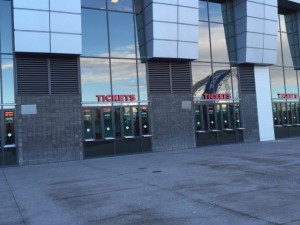
See the big air vents? Nobody would tell us which ones were ‘faux vents,’ there to hide DAS antennas
The complex owner and operator relationships involved in the stadium and surrounding-area DAS also seem tailor-made for a big, experienced provider like Crown Castle, which has a long history of deploying and operating multiple-tenant networks. With five different landlords and four different carriers, being the neutral DAS host for this year’s Super Bowl is a task with many moving parts; but, as Mike Kavanagh, president of sales for Crown Castle’s small cell solutions, said, “We understand how to run networks, how to manage them and deal with carriers. It’s high touch and very fluid. But we know that business.”
COMING UP NEXT: What’s inside the network inside the stadium.
MORE PICTURES BELOW! (Click on any picture for a larger image.)
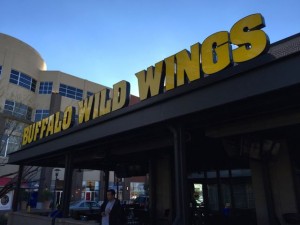
Here’s the official Super Bowl replay HQ (actually a place with DAS antennas on the roof that you can’t see)
